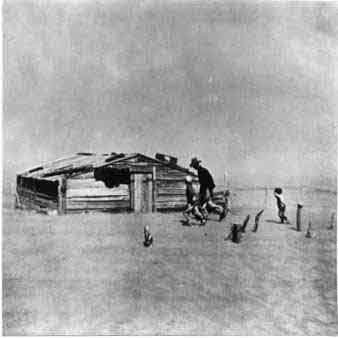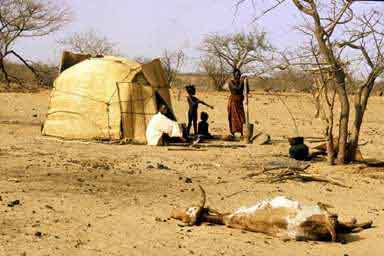The word desertification was first used in 1949 by the French geographer Andre Aubreville to describe the change in North and equatorial Africa from productive savanna forest, grasslands, and shrublands into unproductive desert. Compared to the 2000 slump in tech stocks or the September 11, 2001 attacks, desertification is not an issue for most North Americans.
 |
| Fleeing a dust storm, Cimarron County, Oklahoma, USA, 1936. Arthur Rothstein for the Farm Services Administration. |
Massive erosion during North America's Dust Bowl years (1931-1938) has been blamed on inappropriate use of technology (ploughing the prairies), overpopulation in the affected region, and lack of rainfall. Many people believe that the problems related to the Dust Bowl have been solved--by resettlement of some of the remaining population, the establishment of National Grasslands and the Soil Conservation Service, government spending and regulation, and the return in most years of "normal rainfall."
 |
| Drought refugees, Oklahoma, USA, 1936. Dorothea Lange for the Farm Services Administration. |
Yet the United Nations reports that Texas and New Mexico are some of the fastest, most severely desertifying areas of the world. We have lots of names for this problem: droughts and floods, weeds, overgrazing, wildfire, endangered species, and the chronic downtrodden state of the agricultural economy (in spite of massive subsidies, enormous technical improvements, and overseas markets). These are problems for that tiny sector of the economy known as agriculture. We have separate government agencies in charge of each of the symptoms.
However, these "rural problems" turn into urban problems. Where do our families come from? In North America we are usually not more than three or four generations away from the land. In Nigeria, the abandonment of the countryside for the cities is much more recent.
According to the U.N.'s Kofi Annan, "drought and desertification threaten the livelihood of over 1 billion people in more than 110 countries around the world." Reports the U.N. Convention to Combat Desertification, "70 percent of the world's drylands (excluding hyper-arid deserts), or some 3,600 million hectares, are degraded."
In 1992, Rhodesian wildlife biologist Allan Savory came to a startling conclusion. Most experts on desertification blame overpopulation, overstocking with livestock, overcutting of trees, poverty, warfare, inadequate technology or education, the tragedy of the commons, or shifting cultivation. In West Texas, where Savory was working at the time, none of these causes were present. Rural population was declining, livestock numbers were way down from earlier decades, mesquite trees were encroaching, and there was peace. Money, technology, and education were abundant, all land was privately owned, and there was no shifting cultivation. Yet West Texas was desertifying as rapidly as the worst areas of Africa or Asia.
 |
| Destitute nomads in Burkina Faso. |
Savory concluded that the decision framework that most people use, and in which they are unconsciously trained, is well adapted to treat symptoms, but to leave the causes unaddressed. Savory was forced to conclude that the lack of a holistic decision framework was the fundamental cause of human-induced desertification, in both ancient and modern times. His book Holistic Management: A New Framework for Decision Making (1998) is a simple and dedicated attempt to provide a usable alternative.
By 1992 the United Nations Environment Programme had spent US$6 billion treating the symptoms of desertification, with another $450 billion called for. Though some people are skeptical of the U.N.'s figures for the rate at which productive land is turning into unproductive desert, the reality worldwide is that land deterioration continues to have a serious impact on the quality of people's lives. We owe it to ourselves and to future generations to understand the causes of desertification and loss of biodiversity and to support the numerous practitioners of cost-effective, successful approaches. It is our premise that the common denominator of these approaches is that they consciously seek to manage wholes, rather than just parts.
This website is full of articles that detail success, and explanations of the background knowledge and skill that enables people to succeed--in spite of powerful habits, training, and conditioning that tend to keep most of us operating in linear or conventional decision frameworks.
- See Paradigms and Decision Frameworks article for an overview, and articles from the menu at left for examples.
- Reversing desertification--photos and articles.
- Our overgrazing page.
- Photos of ecosystem function and dysfunction.
- Thomas Elpel's The American Sahara page; good article with pictures and links.
 |
| Advancing dunes near Hawthorne, Nevada, USA. |